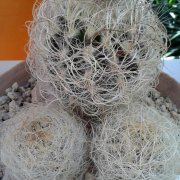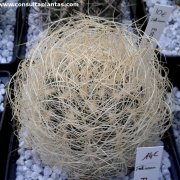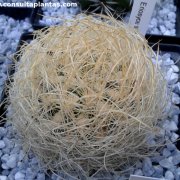Care of the cactus Eriosyce senilis or Neoporteria senilis |
|
The genus Eriosyce, family Cactaceae, includes 35 species of cactus native to Chile, Peru, and Argentina. Some species are: Eriosyce senilis, Eriosyce paucicostata, Eriosyce napina, Eriosyce esmeraldana, Eriosyce crispa, Eriosyce taltalensis, Eriosyce curvispina, Eriosyce aurata. Scientific synonyms: Echinocactus senilis, Neoporteria senilis. This species is native to central Chile. They are small cacti with a spherical body that become cylindrical and reach 8 cm (3.14") in height. They have 16-18 ribs with spirally arranged tubercles. The epidermis is greenish-gray in color but is usually hidden by abundant flexible white spines (up to 20 per areola). They produce showy deep pink flowers 5 cm (1.96") in length. Echinocactus senilis is only used in pots and planters due to their small size. It's ideal for mini cactus gardens combined with other Eriosyce and Mammillaria species. Eriosyce senilis needs direct sun exposure. Indoors it should be located next to a window and have good ventilation. In winter the temperature should not be less than 4 ºC (39.2 ºF). The soil can be a mixture of coarse siliceous sand, vermiculite, and loamy garden substrate. It prefers deep pots because of the napiform root. Water moderately at the rate of every 10-15 days in spring, every 7 days in summer, every 20-25 days in autumn and do not water in winter. Fertilize in spring with mineral fertilizer for cacti. Neoporteria senilis does not need pruning. Eriosyce senilis is sensitive to excess watering and humidity. Echinocactus senilis propagates from seeds sown in spring but it's a slow process. |
Images of the cactus Eriosyce senilis or Neoporteria senilis |
Find plants
Eriosyce senilis or Neoporteria senilis | Care and Growing
© 2025 FavThemes







